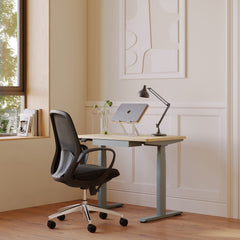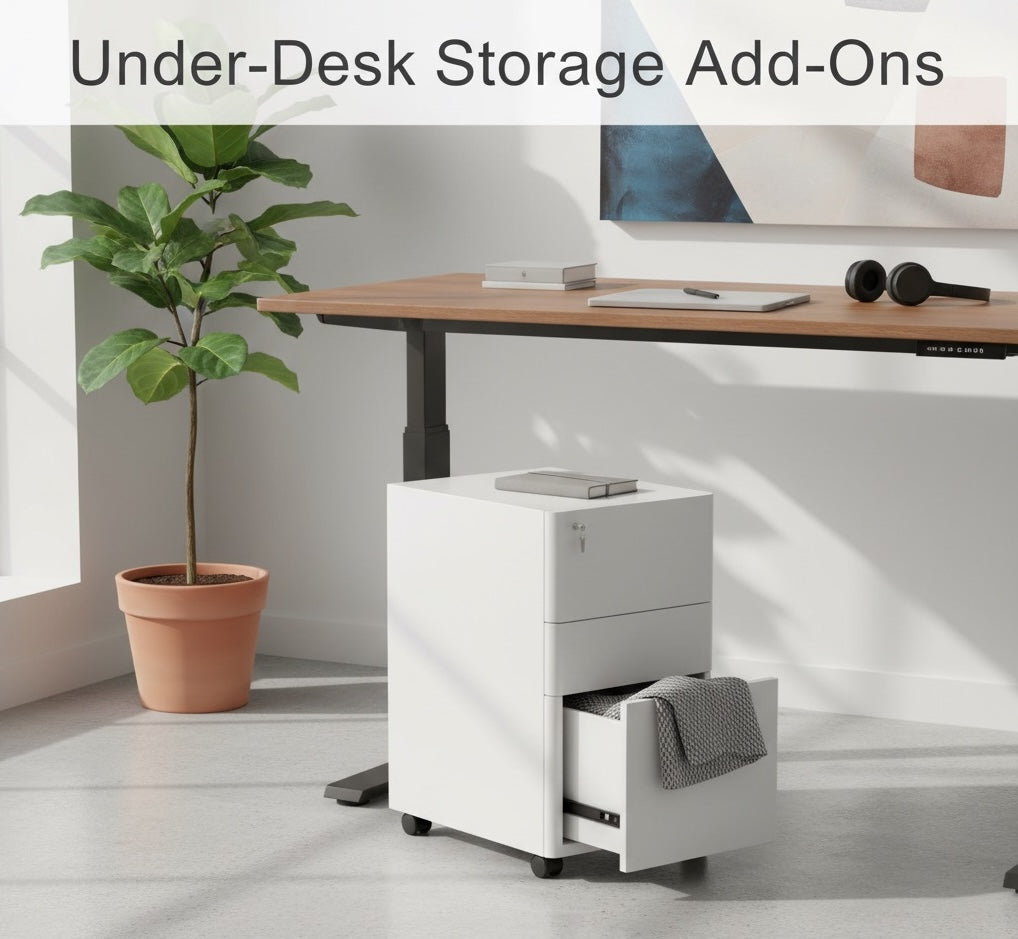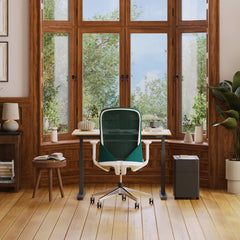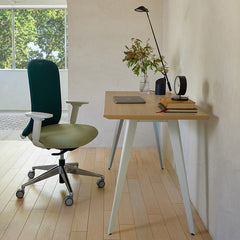Get 10% off your first order
Find the office furniture that’s designed to match your style, comfort, and needs perfectly. Subscribe
Space Shift: The Art of the Live-Work Fusion

Visit quiz page to see how we makes it easy to create an inspiring workplace


A high-performing workstation begins where most people never look. The space beneath the desktop sets the tone for comfort, order, and flow. When this area is choreographed with the right add-ons, the entire environment becomes calmer, safer, and easier to use. The following blueprint turns under-desk real estate into a quiet engine for productivity with placements, materials, and accessories that support healthy posture, smart power, and clutter-free focus.
Successful under-desk organization starts with a map. Before choosing accessories, define zones for legs, power, storage, and cable routes, then confirm that each zone supports the way you actually work.
Place the primary leg corridor at the center of the desk. Keep the first 18 to 24 inches from the front edge free of hard fixtures whenever possible. Position frequently accessed drawers within a comfortable reach on the non-dominant side to reduce shoulder rotation. Reserve the far rear underside for fixed trays or hubs that do not require frequent interaction.
Equipment and power accessories generate heat. Maintain small air gaps around cable trays and vertical spines to encourage airflow, and leave clearance so vacuums or brooms can pass through without collisions. Cleaning access prevents dust build-up that can trap heat and cause cable abrasion.
Measure knee height and thigh clearance with shoes on while the chair is set at working posture. Note where your knees move during rolling or swiveling. Mark those arcs with painter’s tape under the desktop to guide where trays, drawers, and power modules should not go.
Electricity should be easy to reach and hard to see. The goal is safe access without visual noise, so devices connect quickly while the desktop remains clear.
An integrated power access module routes plugs through the work surface and into concealed wiring paths. This approach favors permanent setups, limits cord drag across the edge of the desk, and keeps chargers where you need them without creating clutter on top.
A versatile clamp-on outlet hub supports teams that rearrange furniture or individuals who frequently shift zones. The clamp attaches to the desk edge, places outlets within an easy reach, and relocates without tools. It is a reliable option for rental spaces or hybrid work where permanent drilling is not an option.
Label chargers by device type, route cables in parallel runs, and avoid tight bends around desk hardware. Keep surge protection accessible but not in the leg corridor. Group low-voltage items together to simplify troubleshooting.
The most visible sign of under-desk order is almost invisible. Cable management guides wiring along predictable paths, reduces snags, and prevents accidental disconnections.
A flexible cable spine organizer carries cords from the desktop to the floor with a clean line that moves as the desk height changes. The segmented design protects cables from pinch points and helps maintain a tidy silhouette in open offices.
An under-mounted cable tray system captures excess cable length, power strips, and adapters directly beneath the surface. This keeps cords off the floor and away from feet. Horizontal containment often pairs well with grommeted power and fixed monitors.
| Dimension | Vertical Spine Organizer | Under-Desk Tray System |
|---|---|---|
| Movement compatibility | Excellent for sit-stand ranges | Good for fixed-height desks |
| Visual presence | Architectural accent | Nearly invisible |
| Capacity mix | Ideal for power plus data | Effective for power bricks and coils |
| Best placement | Rear edge near lifting columns | Rear underside, centered or offset |
Use radius-friendly loops at corners, apply Velcro ties instead of rigid zip ties where maintenance is frequent, and separate power from data where interference is a concern. Leave small service loops that allow you to pull a device for cleaning without unplugging.
Under-desk storage should serve the work rather than crowd the legs. Select pieces that move smoothly, protect documents or tools, and match the visual tone of the desk.
A mobile filing cabinet on casters offers lockable storage, a small footprint, and the ability to shift position when hosting guests, changing tasks, or cleaning. Place the unit on the non-dominant side to keep the primary leg corridor open.
Shallow pull-outs and pencil trays store small items without invading knee space. Mount these toward the outer edges rather than the center of the desk to prevent contact when shifting position. Use drawer dividers for cables, adapters, and stationery to avoid rummaging.
Position daily-use items in the top drawer or closest tray, weekly items in the lower drawer, and archive materials in the cabinet furthest from knees. This tiering ensures the quickest items are within the shortest reach and reduces unnecessary bending.
Flexible accessories keep a workspace consistent as your environment changes, which reduces context switching and setup time.
A compact standing desk converter can be staged under or beside a main desk when not in use, then lifted into position when you want to alternate posture. It can hold a laptop or secondary display temporarily, and it doubles as additional staging space for paperwork during intense review sessions.
Rolling pedestals, small caddies, and removable cable clips let you shift peripherals without disrupting core cable routes. Keep a small go-bag with essentials that mirrors your desk layout so the same tools are always easy to find.
Avoid deep shelving in the central under-desk zone. When adding hooks or headphone rests, place them toward the rear sides to prevent knee contact. Leave at least two hand-widths of open space alongside each thigh corridor for comfort.
Under-desk improvements should reinforce healthy posture rather than compete with it. The right choices support neutral joints, steady circulation, and smooth micro-movements.
Think of the chair, keyboard area, and storage as corners of a triangle. When drawers sit too far forward, the knee has to angle outward with each reach. When the triangle is compact and unobstructed, you minimize hip rotation and shoulder reach, which helps maintain neutral alignment for longer sessions.
An ergonomic office chair complements a tidy under-desk area by maintaining consistent posture while you access drawers or rotate toward side surfaces. Adjustable arm height and seat depth preserve clearance for mobile cabinets and trays.
Air that circulates around legs reduces fatigue from heat buildup. Maintain gaps behind trays and along the floor to encourage airflow. If the desk houses a small computer tower nearby, keep intake and exhaust paths free of fabric panels or stacked storage.
The CDC’s ergonomics research underscores the value of neutral postures, balanced reach, and low-force interactions. Under-desk placement that honors these fundamentals can contribute to better comfort, fewer awkward movements, and more consistent productivity.
The right materials protect equipment and skin, resist wear, and set a calm tone for the space.
Powder-coated steel trays and brackets handle cable abrasion and wipe clean easily. Soft-touch liners inside drawers reduce rattling and protect device finishes. Rounded edges and chamfered corners minimize accidental contact with knees and shins.
Match the undertone of the desk frame when possible. Black, charcoal, or warm gray trays tend to recede visually. Where desks are light wood, consider similar-toned storage fronts to keep the look consistent. Consistency lowers visual load and can make the workspace feel larger.
Use hardware that matches the mounting surface. Pilot holes and short screws help protect thin desktops, while adhesive channels offer an alternative for renters. Periodically check torque on brackets to prevent slow drift under the weight of power bricks.
Installation should be neat, reversible when needed, and documented for easy updates.
1. Mark leg corridors with tape.
2. Test-fit trays and drawers with clamps before drilling.
3. Route mock cable paths using loose ties.
4. Confirm chair clearance and foot movement.
5. Set final positions, then drill or apply adhesive.
6. Label cables and place service loops last.
Where drilling is not preferred, use clamp-on hubs, adhesive-backed channels, and freestanding drawers. These solutions protect delicate veneers and allow for repositioning as needs evolve.
Photograph cable paths and record the screw types and positions. A simple diagram helps during future equipment swaps and minimizes downtime.
Good storage is safe storage. Build small habits into the setup so the system remains orderly over time.
Keep cords away from casters and foot rings. Secure vertical runs at top and bottom. Do not cross power cords through the footrest zone, and avoid hard bends where cables pass through tray edges.
Dust trays and spines during routine cleaning, check Velcro straps for slippage, and verify that casters roll smoothly. Replace worn adhesive channels before they fail. A five-minute monthly check prevents most small problems from growing.
Use cable identification for monitors, docks, and peripherals. When swapping devices, unplug at the hub rather than pulling on cable jackets. Keep small desiccant packs in drawers that store electronics in humid environments.
Different roles demand different under-desk patterns. Shape the space around the primary motions of the day.
Prioritize stable power and data pathways. Place the tray toward the rear center for clean monitor routing, and mount a small hook for headphones on the side away from the mouse arm. Leave headroom for sit-stand transitions.
Enable quick staging space with a movable drawer and a nearby platform that can hold sketchbooks or tablets. Route stylus chargers and camera cables through a dedicated channel to keep them separate from keyboard wiring.
Keep document access close with a small pedestal and a shallow pull-out for pens and notepads. Provide two open outlets at the front corner for guests who need temporary power.
Even compact rooms can feel generous when the underside of the desk is well organized.
Choose one primary storage unit rather than several small ones. Favor a single cable tray that runs the width of the desk instead of multiple short channels. Use slim hooks for bags or headphones near the rear to keep side aisles open.
Keep everything below eye height out of direct sightlines. Use materials that match the desk frame so the system blends into the background. A tidy underside reduces the visual weight of monitors and arms on top.
Use this checklist to assess performance and comfort after install. If any response is no, adjust placement or component choice.
Can you slide the chair to working position without contacting a drawer or tray
Can you stand and sit without cables tugging
Can you vacuum or sweep without moving storage units
Can you unplug a device without reaching behind your knees
Can you remove dust from trays by hand in less than two minutes
Can you identify each cable by label without tracing it by hand
The most effective under-desk systems are not defined by quantity but by cohesion. Every element, from storage drawers to cable routing, should align with the daily rhythm of work. When power access, mobility, and ergonomics come together through intentional planning, the entire desk environment becomes an extension of focus and comfort.
Spatial intelligence goes beyond aesthetics. It means understanding how motion, reach, and visibility interact under the desk. Accessories placed with precision reduce fatigue and time lost to searching or repositioning. This subtle choreography of motion and storage builds a rhythm that improves both productivity and mood throughout the day.
Work environments differ across climates, building types, and cultures. Considering regional factors like floor types, ambient temperature, and available power configurations ensures every under-desk system functions safely and efficiently. Compact spaces may prioritize vertical storage, while larger layouts can benefit from extended trays and multi-zone cable paths. Adapting to these nuances reflects the true goal of workplace design: a system that fits its setting as naturally as it fits the person using it.
Human-centered design views under-desk add-ons as extensions of well-being. Choosing materials that are durable, easy to clean, and responsibly sourced keeps the environment healthy and sustainable. Simple maintenance habits—like checking mounts, cleaning trays, and reviewing cable integrity—protect both the user and the workspace investment. Over time, these small acts create a resilient and trustworthy setup that continues to perform quietly and effectively.
An organized under-desk area doesn’t draw attention; it simply removes obstacles. The absence of clutter, noise, and obstruction creates a sense of steady calm that fuels consistent performance. Each drawer that opens smoothly and each cable that disappears into the background contributes to an invisible foundation of productivity. Thoughtful order, not abundance, defines a workspace that truly works as hard as its user.

Space Shift: The Art of the Live-Work Fusion

How to Arrange Furniture to Maximize Peace

Crafting Calm: Your Guide to the Perfect Reading Corner
Get 10% off your first order
Find the office furniture that’s designed to match your style, comfort, and needs perfectly. Subscribe
Leave a comment